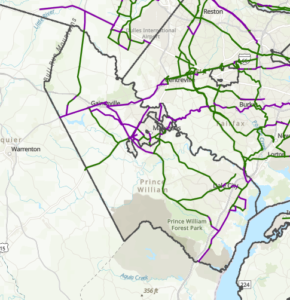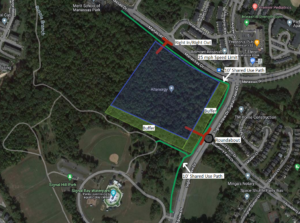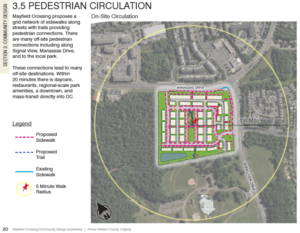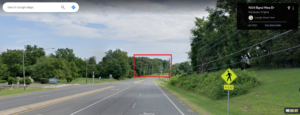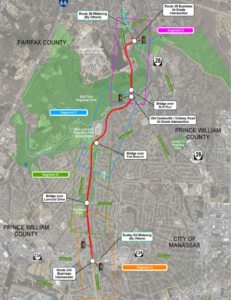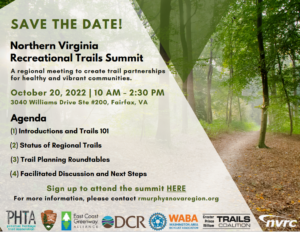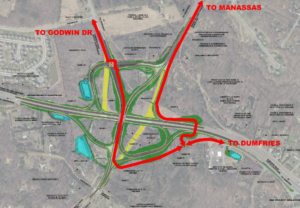
Routing for bicyclists and pedestrians in the approved Route 234/Brentsville Road Interchange Project design
In early February 2024, Active Prince William asked the Prince William County Department of Transportation to improve pedestrian and bicycle access and safety between the Business Route 234/Dumfries Road corridor in the vicinity of Godwin Drive and the Route 234/Brentsville Road Interchange project, which is nearing the end of its construction. County staff replied that they will look into our request but did not commit to any action. Our written request is copied below.
Potomac Local’s recent update on the Route 234/Brentsville Road Interchange project reported that this $55 million project is currently $2 million under budget.
We are inquiring about the County’s plans for safe and convenient pedestrian and bicycle access along the Business Route 234/Dumfries Road corridor between the new interchange and the City of Manassas. From previous correspondence, Mr. Belita indicated a ten-foot wide shared use path will be built along the west side of Business Route 234/Dumfries Road between the Bradley Cemetery Way area and Godwin Drive.
We firmly believe that 10-foot wide shared use paths are needed along both sides of Business Route 234 to provide reasonable and much-needed pedestrian and bicycle access to and from this Interchange.
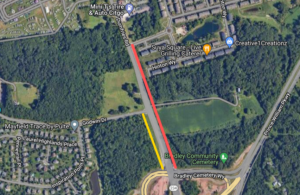
Along the west side of Business Route 234, the shared-use path between at least Godwin Drive and the Bradley Cemetery Way area will provide safe foot and bicycle access to and from Godwin Drive heading west (including to the adjacent Mayfield Trace community) and could also connect to a future northwestern extension of the regionally significant shared-use path along the Prince William Parkway leading from the Brentsville Road Interchange. In addition, the nearest shared-use path within the City of Manassas is along the west side of Business Route 234, between Hastings Drive and Donner Drive.
Along the east side of Business Route 234, a shared-use path from the Bradley Cemetery Way area would provide optimal access to the shared-use paths being built within this Interchange project that a) head south to cross over Route 234 to reach both Brentsville Rd heading south and the existing regional path along southbound Route 234 and that b) meander east through the Interchange to reach Liberia Avenue Extended/Route 294 toward Manassas.
A shared-use path along the east side of Business Route 234 would optimally connect to the existing Bradley Square townhome development and the proposed Bradley South (REZ2003-00027) development. From Bradley Manor Place, the existing Bradley Square subdivision streets readily lead to South Grant Avenue in the City of Manassas, a pleasant, existing low-traffic route for bicycling and walking that connects to Wellington Road (and from there to downtown Manassas via multiple routes).
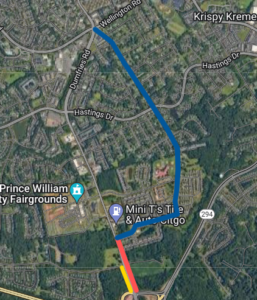
We are disappointed that the current Bradley South rezoning proposal is rather inhospitable for bicycling and walking. Business Route 234/Dumfries Road would have a 50 MPH design speed and a 45 MPH posted speed limit, and the developer of Bradley South would only be required to proffer a sidewalk along the east side of Dumfries Rd. By contrast, the connecting segment of Dumfries Road at the south end of the City of Manassas has only a 35 MPH posted speed limit (which is better but also too high in our opinion).
Furthermore, with continued residential, commercial, and mixed-use development along the Business Route 234/Dumfries Road corridor (including the Prince William County Fairgrounds), just south of the Manassas City Limits, the density of development will be comparable to that planned along Centreville Road (Route 28) in Yorkshire.
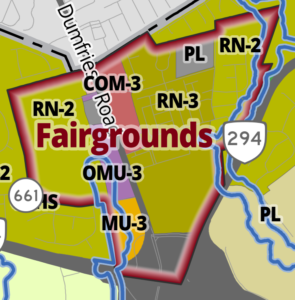
We ask that the budget surplus from this project and proffers from the Bradley South rezoning be used to provide a 10-foot wide shared-use path along the east side of that roadway (Dumfries Rd), from the Bradley Cemetery Way area to at least Bradley Manor Place.
Beyond that, to the extent feasible, the Interchange Project budget should also provide much-needed pedestrian infrastructure for crossing Business Route 234/Dumfries Road at Godwin Drive, including high-visibility crosswalks, at least one raised pedestrian crossing refuge within the roadway median, and either a pedestrian-activated crossing beacon (e.g., HAWK signal) or a conventional traffic signal with full pedestrian crossing components for at least two of the existing intersection legs.
Please let us know how the Route 234/Brentsville Road Interchange Project will suitably accommodate active mobility to and from the already well populated Business Route 234/Dumfries Road corridor.
Without safe and convenient foot and bike connections to the new Interchange from Business Route 234, the new Interchange will degrade active mobility to and from that populated corridor, and the new active transportation infrastructure within the interchange will be very underutilized. Waiting five or more years for possible future rezonings along Business Route 234/Dumfries Road is not acceptable to complete these critical sections.
If the surplus funds from the Interchange project cannot be tapped to build either another shared-use path or a signalized pedestrian crossing of Business Route 234/Dumfries Road at Godwin Drive, we believe that low-cost or no-cost alternative interim improvements could readily be implemented along the east side of Business Route 234/Dumfries Road that would still substantially improve pedestrian and bicycle access and safety between the Bradley Cemetery Way area and Bradley Manor Place.
Google Street View shows that–before the Interchange was constructed–the paved width of Business Route 234/Dumfries Road was already about four or five lanes wide (i..e., 48 to 60 feet of asphalt pavement) for most of the distance between Bradley Cemetery Way and Bradley Manor Place. There appears to be only a short stretch between Godwin Drive and the south end of Bradley Square where the pavement narrows to about 36 feet, but only two lanes are presently needed for vehicular travel along that segment.
- Northbound Dumfries Rd approaching Bradley Cemetery Way
- Northbound Dumfries Rd approaching Godwin Drive:
- “Pinchpoint” along northbound Dumfries Rd between Godwin Drive and Bradley Square
- Northbound Dumfries Rd approaching long right-turn-only lane south of Bradley Manor Place
- Northbound Dumfries Rd approaching Bradley Manor Place
Thus, the restriping of that roadway segment (with or without any asphalt resurfacing) should allow for at least a continuous 10-foot or wider northbound paved shoulder area leading up to the long right-turn-only lane approaching Bradley Manor Place. That shoulder area could be protected from roadway traffic with some sort of hard physical barrier to serve as an interim shared-use path along the east side of Business Route 234/Dumfries Road between the Bradley Cemetery Way area and Bradley Manor Place.
This recent photo (below) of northbound Route 234 Business/Dumfries Road near Bradley Cemetery Way shows that a wide paved shoulder is already present at that location. While less wide than optimal, that existing paved shoulder could serve as an interim two-way shared-use path if it’s protected from the roadway traffic with a suitable hard barrier.
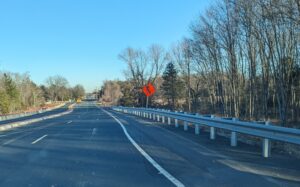
Northbound Business Route 234/Dumfries Road just north of the Interchange on February5, 2024
In addition, a striped conventional bike lane in each direction may also be feasible. In the southbound direction, a striped on-road bike lane would be especially useful, from the Manassas City Line to Godwin Drive, for the dozens of bicyclists who participate in Bull Run Bicycles Tuesday Evening Shop Ride, almost every Tuesday evening during daylight saving time. South of Godwin Drive, a southbound bike lane should not be needed because a new shared-use path will be located along that segment.
Finally, we again request that whatever pedestrian and bicycling improvements cannot be accomplished under the current Interchange project become required proffers as part of the Bradley South rezoning.
